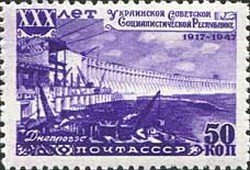Stamp: Reconstrusting Dam of Dnieper Hydroelectric Station (Soviet Union, USSR 1948)
Reconstrusting Dam of Dnieper Hydroelectric Station (Soviet Union, USSR 1948)
25 January (Soviet Union, USSR ) within release Anniversaries goes into circulation Stamp Reconstrusting Dam of Dnieper Hydroelectric Station face value 50 Russian kopek
| Stamp Reconstrusting Dam of Dnieper Hydroelectric Station in catalogues | |
|---|---|
| Michel: | Mi:SU 1187 |
Stamp is horizontal format.
Also in the issue Anniversaries:
- Stamp - House of Ukrainian SSR Council of Ministers in Kiev face value 30;
- Stamp - Reconstrusting Dam of Dnieper Hydroelectric Station face value 50;
- Stamp - Wheat harvesting face value 60;
Stamp Reconstrusting Dam of Dnieper Hydroelectric Station it reflects the thematic directions:
An economy is an area of the production, distribution and trade, as well as consumption of goods and services. In general, it is defined as a social domain that emphasize the practices, discourses, and material expressions associated with the production, use, and management of resources. A given economy is a set of processes that involves its culture, values, education, technological evolution, history, social organization, political structure, legal systems, and natural resources as main factors. These factors give context, content, and set the conditions and parameters in which an economy functions. In other words, the economic domain is a social domain of interrelated human practices and transactions that does not stand alone.
In microeconomics, an industry is a branch of an economy that produces a closely related set of raw materials, goods, or services.For example, one might refer to the wood industry or to the insurance industry.
A dam is a barrier that stops or restricts the flow of surface water or underground streams. Reservoirs created by dams not only suppress floods but also provide water for activities such as irrigation, human consumption, industrial use, aquaculture, and navigability. Hydropower is often used in conjunction with dams to generate electricity. A dam can also be used to collect or store water which can be evenly distributed between locations. Dams generally serve the primary purpose of retaining water, while other structures such as floodgates or levees (also known as dikes) are used to manage or prevent water flow into specific land regions.
A crane is a machine used to move materials both vertically and horizontally, utilizing a system of a boom, hoist, wire ropes or chains, and sheaves for lifting and relocating heavy objects within the swing of its boom. The device uses one or more simple machines, such as the lever and pulley, to create mechanical advantage to do its work. Cranes are commonly employed in transportation for the loading and unloading of freight, in construction for the movement of materials, and in manufacturing for the assembling of heavy equipment.
An anniversary is the date on which an event took place or an institution was founded in a previous year, and may also refer to the commemoration or celebration of that event. For example, the first event is the initial occurrence or, if planned, the inaugural of the event. One year later would be the first anniversary of that event. The word was first used for Catholic feasts to commemorate saints. Most countries celebrate national anniversaries, typically called national days. These could be the date of independence of the nation or the adoption of a new constitution or form of government. The important dates in a sitting monarch's reign may also be commemorated, an event often referred to as a "Jubilee".




